Brainstem Anatomy and Cranial Nerve Nuclei 1
1/14
There's no tags or description
Looks like no tags are added yet.
Name | Mastery | Learn | Test | Matching | Spaced |
|---|
No study sessions yet.
15 Terms
What is the passage of the lateral corticospinal tract and how does this relate to injuries?
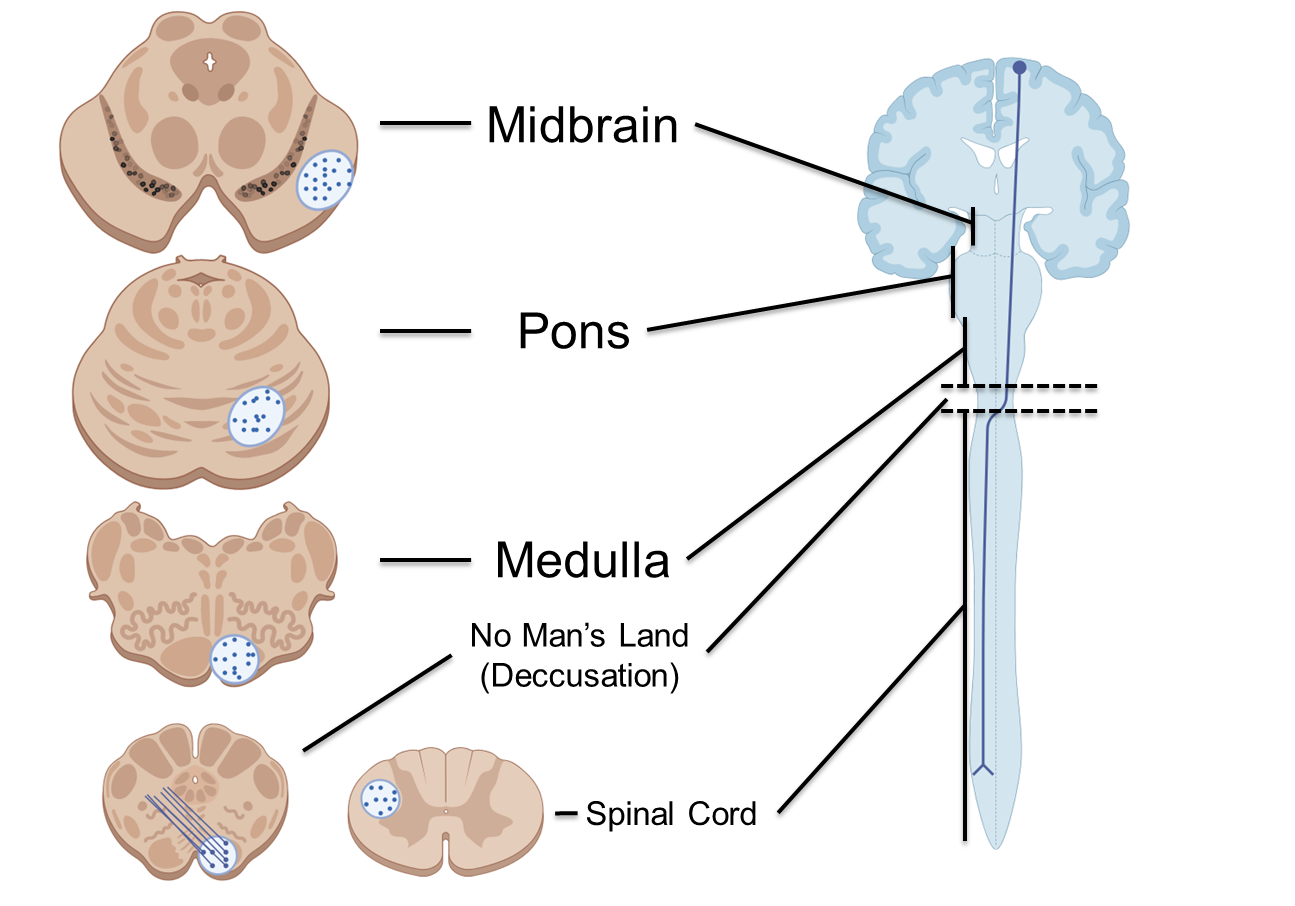
Lateral corticospinal tracts will traverse through the posterior limb of the internal capsule at the genu
→ passes through the cerebral peduncles at the midbrain
→ passes through bridging fibers of the pons
→ passes through the medullary pyramids and then decussates immediately after the medulla
This is important because any point above the medulla, would cause contralateral weakness (right tract causing left sided weakness)
→ any point below the medulla would cause ipsilateral weakness (the right tract has decussated, so it becomes a left nerve and causes left sided weakness)
What is the passage of the dorsal column/medial lemniscus? what do they do and why is it organized this way?
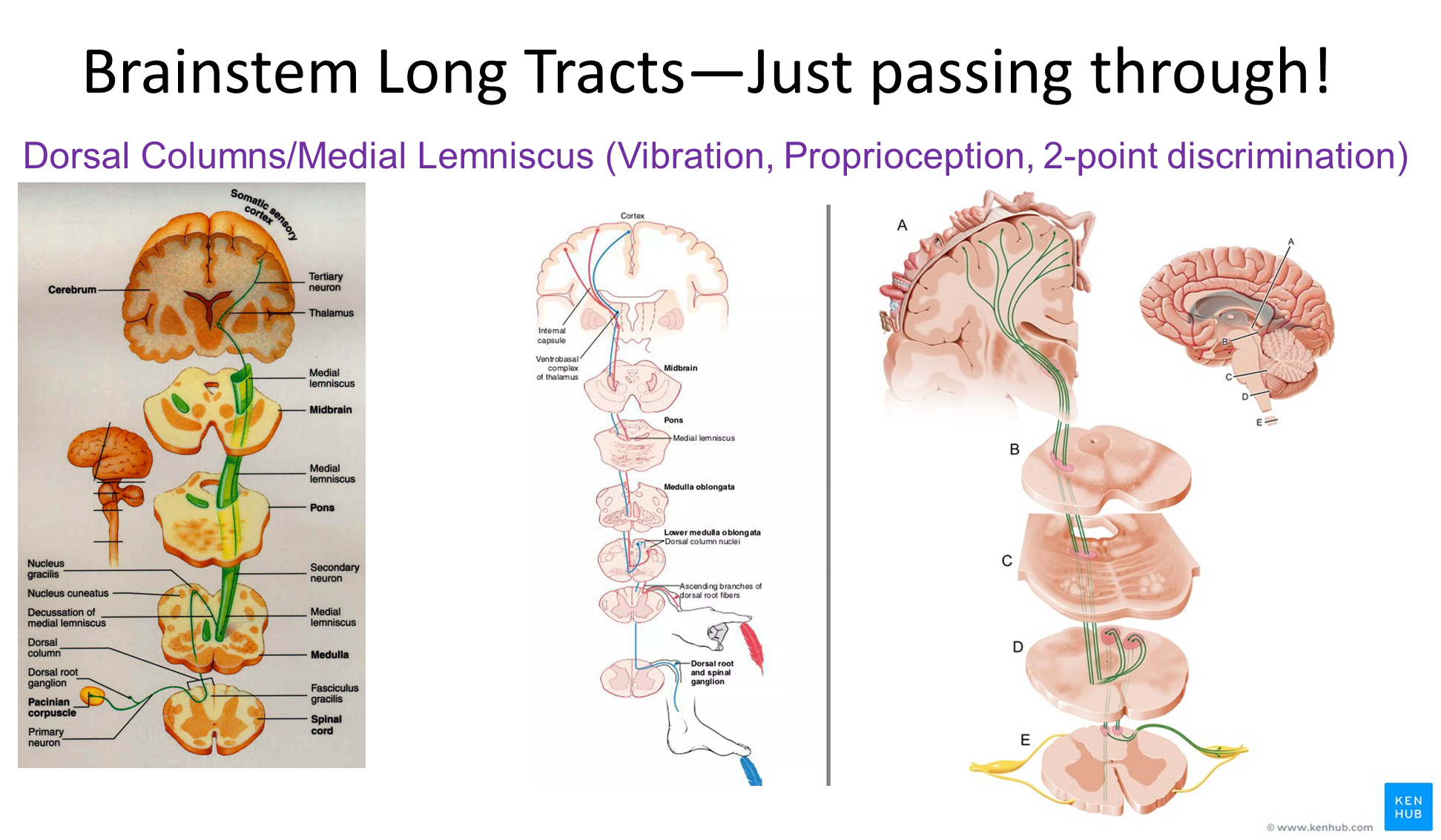
Dorsal Column and Medial Lemniscus is responsible for passage of vibration, proprioception, 2-point discrimination
1) Afferent info from the lower body comes in to the spinal cord where it ascends to the nucleus gracilis where it synapses
→ the fibers will decussate at the nucleus gracilis (below the medulla) and will travel up through the spinal cord where it will enter the brain at the medial lemniscus
2) Afferent info from the upper body enters the spinal cord and ascends via the nucleus cuneatus where it synapses
→ crosses over at the nucleus cuneatus (below the medulla) where it will climb the spinal cord laterally and enter the medial lemniscus at the brain
3) It is organized this way because of the organization of the body
→ lower body fibers enter the cord first, so they end up occupying the middle
→ upper body fibers enter later, getting pushed out laterally
THIS IS THE ONLY PATHWAY IN THE SPINAL CORD WHERE WHITE MATTER FOR THE LOWER BODY IS NOT LATERAL
Where does decussation occur?
Decussation occurs below the medulla
This is important because any point above the medulla, would cause contralateral weakness (right tract causing left sided weakness)
→ any point below the medulla would cause ipsilateral weakness (the right tract has decussated, so it becomes a left nerve and causes left sided weakness)
What is the one exception to the organization of the lower body in the brain?
Most of the time, tracts to the lower body are organized laterally
→ this is only switched with the dorsal column and medial lemniscus where the fibers for the lower part of the body are more medial
1) In the brain the fibers will reorganize where the lower body is more lateral while the upper body is more medial due to the medial lemniscus
What is the passage of the spinothalamic tract?
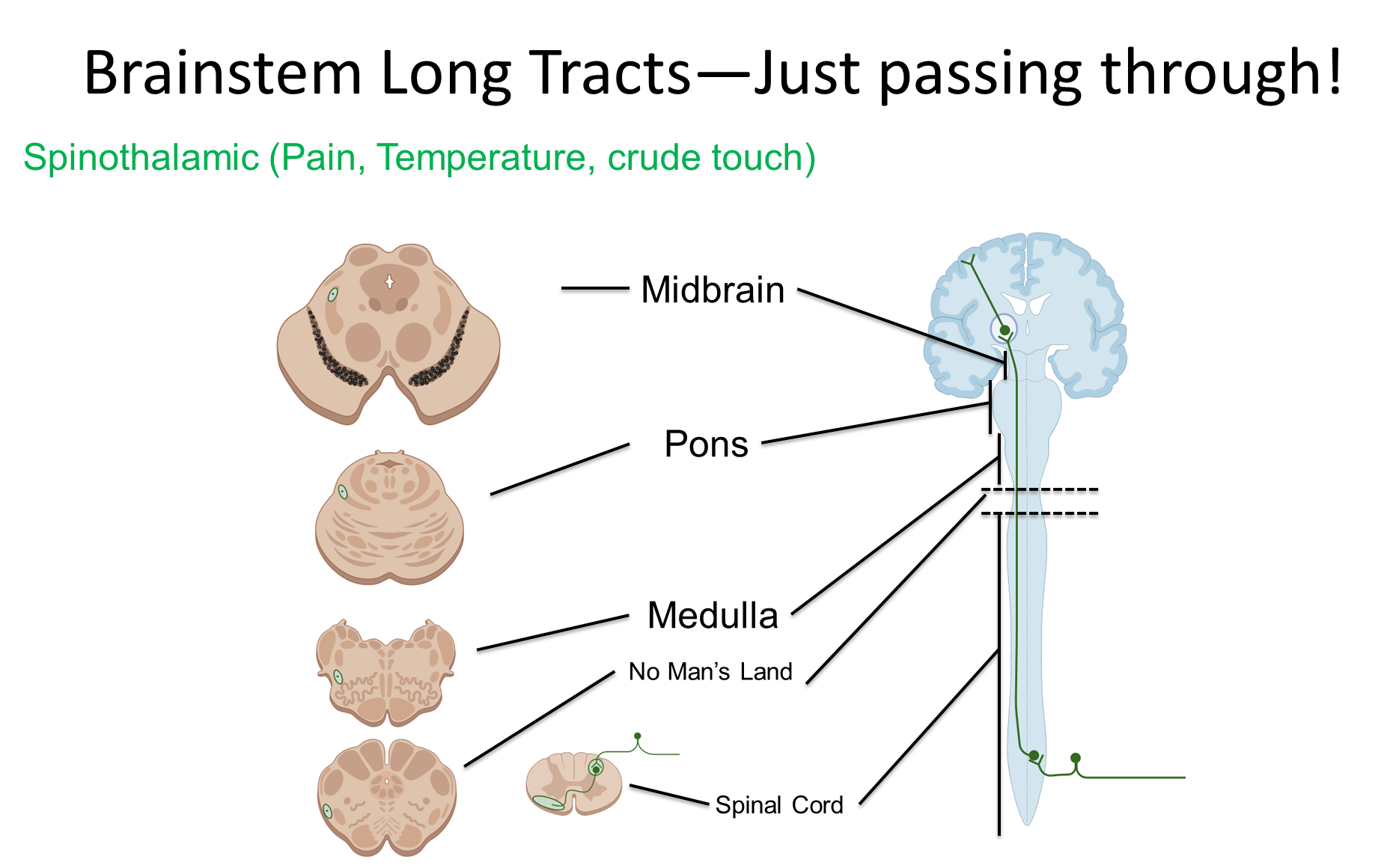
Spinothalamic Tract is responsible for pain, temperature, and crude touch
1) The nerve fibers enter into the spinal cord where they synapse at the nucleus proprius at the dorsal horn of the gray matter
→ will cross here and then travel up to the VPL of the thalamus
2) Importantly, face fibers will synapse at the VPM of the thalamus
What is the organization of sensory vs cranial nerves?
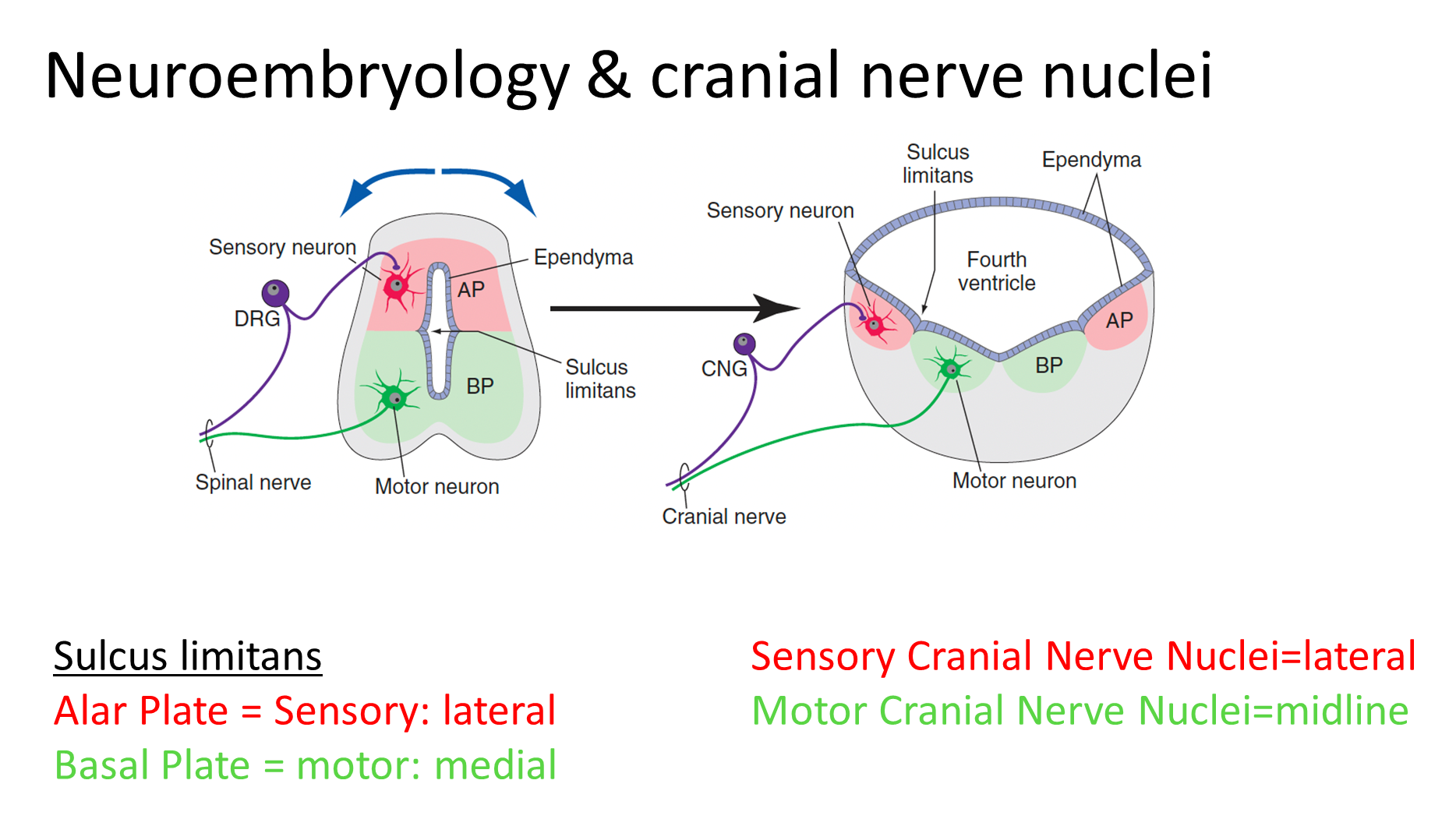
Formation of the Alar Plate (dorsal, sensory) and the Basal Plate (motor, ventral) due to the effects of BMP and Shh, these organizations are maintained
→ these plates begin unfolding, meaning sensory is lateral while motor is usually midline
What are the GSE Nuclei? What are the four main ones?

GSE or general somatic efferent are the cranial nerve nuclei that are responsible for motor innervation to the skeletal muscle derived from somites such as the eye and tongue
There are four:
→ XII/Hypoglossal - muscles of the tongue. found in the medulla
→ VI/Abducens - lateral rectus. found in the pons
→ IV/Trochlear - superior oblique. found in the caudal midbrain
→ III/Oculomotor - every other extraocular muscle. found in the midbrain
Importantly III also contains the Edinger-Westphal nucleus which is a general visceral efferent to the pupil constrictor and ciliary muscles
→ oculomotor parasympathetic pathway
What are the SVE Nuclei?
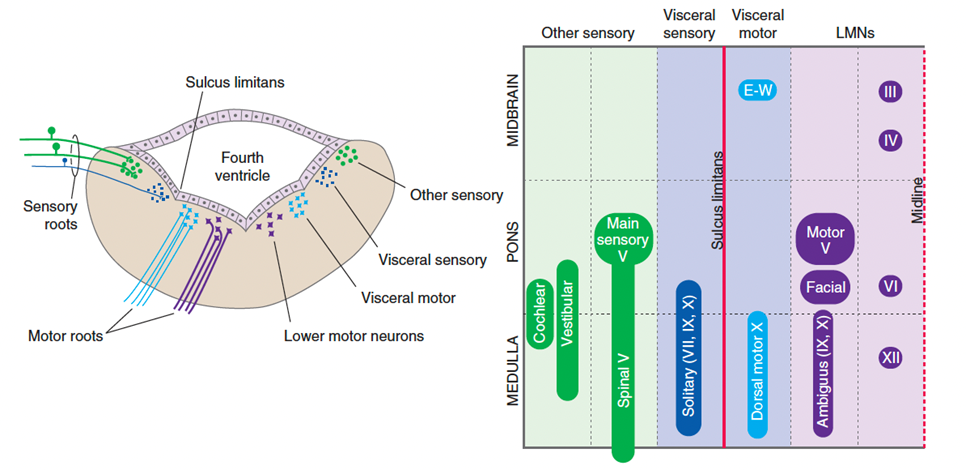
The special visceral efferent nuclei are responsible for controlling skeletal muscle that originates from the branchial and pharyngeal arches
1) Trigeminal V3
→ all muscles of mastication, tensor tympani and palatini, mylohyoid, and anterior digastric
→ found in the mid-pons, where it is directly next to the sensory portion of the trigeminal
2) Facial (VII)
→ muscles of facial expression, stapedius, stylohyoid, posterior digastric
3) Nucleus Ambiguus (IX, X)
→ pharynx, larynx, soft palate
What are the GVE?

GVE or General Visceral Efferent is a motor nuclei classification parasympathetic control of smooth muscle, cardiac muscle and glands
1) Edinger-Westphal (III)
→ parasympathetic to the pupil constrictor and ciliary muscle
2) Dorsal Motor (X)
→ parasympathetics to the thoracic and abdominal viscera
What is SVA?

SVA are special visceral afferent and carries sensory info from special senses such as taste and smell
1) Composed of the solitary nucleus which carries fibers for VII, IX, and X
→ VII - anterior 2/3
→ IX - posterior 1/3
→ X - epiglottis/pharynx
What is GVA?

General Visceral Afferent is sensory fibers carrying information from the internal organs
1) X - Vagus
→ carries information from the baroreceptors and chemoreceptors of the aortic arch/body
2) IX - Glossopharyngeal
→ carries info from the baroreceptor and chemoreceptors of the carotid sinus
→ pharyngeal sensation
What is GSA?

General Somatic Afferent
→ sensory fibers that carry information from the body wall, face, and oral nasal cavities
1) V - Trigeminal Nerve
→ the entire face, the main sensory nucleus of V for vibration, proprioception and two point discrimination. Seen lateral to the motor nuclei of the trigeminal.
→ spinal nucleus of V for pain and temperature - seen at the medulla
2) VII - Facial Nerve
→ eardrum and behind the ear
3) IX - Glossopharyngeal
→ sensory to posterior 1/3 of the tongue, pharynx, tonsil and middle ear
4) X - Vagus
→ sensory to the pharynx and larynx
What is SSA?

Special Somatic Afferent carries fibers for special senses such as vision, hearing and balance
1) CN II - Optic
→ vision
2) CN VIII - Vestibulocochlear
→ hearing
→ balance and vestibular sensation
What is the organization of the seven nuclei from medial to lateral? How about in the brain?
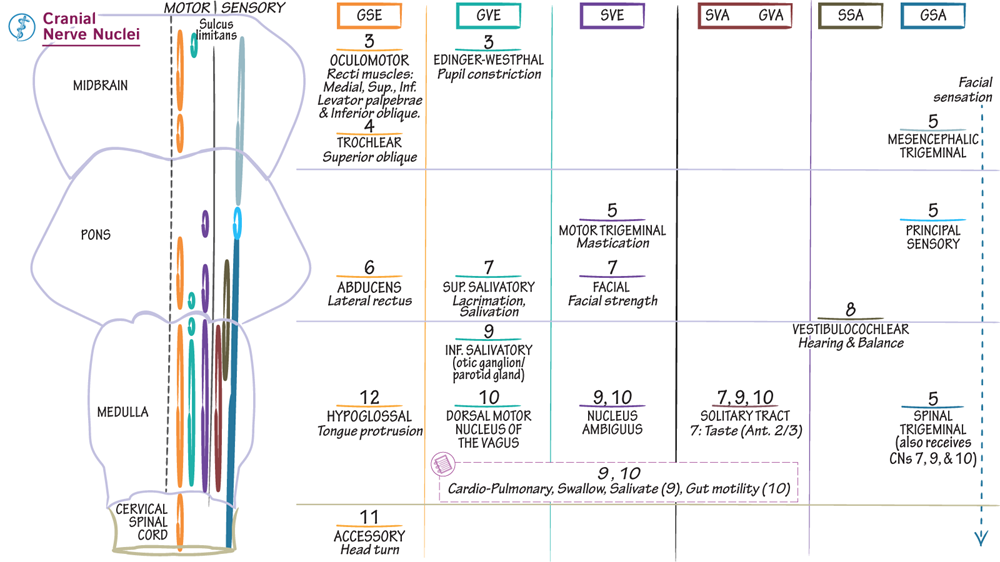
Most Medial to Lateral
→ GSE, GVE, SVE, SVA/GVA, GSA, SSA
Cranial Nerve Nuclei are mostly organized as follows
→ Nuclei 3 and 4 - Midbrain
→ Nuclei 5, 6, 7, and 8 -Pons
→ Nuclei 9, 10, 11, 12 Medulla and spinal cord
How does the trigeminal nerve convey pain and temperature in the face? How is this different from vibration, proprioception and two point discrimination

1) Sensory information for pain and temperature will descend in the spinal trigeminal tract where it will synapse at the spinal trigeminal nucleus
→ from the spinal trigeminal nucleus, second order neurons will decussate and ascend the trigeminothalamic tract
→ will converge at the ventral posterior medial nucleus of the thalamus
2) This is in contrast to vibration, proprioception and two point discrimination of the face which is in the main sensory nucleus of V
→ crosses immediately at the sensory nucleus of V to travel to the VPM
3) Importantly this will receive inputs for pain and temperature from VII, IX, and X for pain the mouth and pharynx/larynx